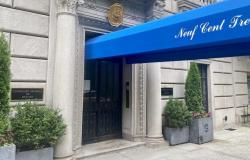By
Laura Bourven
Published on
June 1, 2024 at 8:00 a.m.
See my news
Follow the Marne
From her office, Audrey Chaix, director of the Pays de Meaux Great War Museum, keeps an eye on the construction site. Its window overlooks part of the museum park in full transformation. Since April 2024, the green space which follows the square, to the right of the visitors’ entrance, is no longer.
Now resides in piles of earth and construction equipment. The museum is preparing its land to set up, after the summer, a large immersive educational trench outdoors of a little less than 1,000 square meters.
Show real life in the trenches
The First World War was “the trench warfare », expression used to designate the period of positional warfare. Each camp remained static, inside trenches where life was organized. Between the French and German lines: a “no man’s land”, a land without men, a desert space behind barbed wire. This is what the museum wanted to represent with this new trench.
“Inside the museum we already have two pieces of trench, one German and the other French, but visitors can’t walk around in it », recalls Audrey Chaix. The objective for the Great War Museum was therefore to go further and realize this desire for several years to create a trench for educational purposes. as realistic as possible.
Two real lines of trenches
The public will have access to this new trench, from November 2024, from inside the museum. “There will be a path to go down into the trench,” describes the director of the Great War museum. Before rushing into the meanders, visitors will be able to overlook to understand how it works, distinguish the different lines and living spaces.
Because, and this is unique for a French museum, this trench of almost 1,000 square meters over 100 meters of walking will represent well two lines and all the different characteristics that allowed soldiers to live for many months underground. The course will also be totally immersive with distant sounds, then precise sounds of gunfire, battle planes, etc.
The public will be in a bubble, they must lose their bearings.
Entry will be via the second line, the one furthest from the front, and therefore from “no man’s land”. Here, there will be living spaces, latrines, and even the first aid station.
Gradually, the public will approach the shooting zone, with the first line. He will be able to see the shooting benches, take a look at the “no man’s land” between two prison plates, observe a basic shelter in the rock, the listening post for enemy troops, or even the representation of a hole undermining, deep tunnel allowing movement without being seen by the enemy.
Each space will be accompanied by mediation panels with explanations. To go further, QR codes can be scanned to obtain more iconographic content and video archives. “The idea is to provide as much information as possible.”
A reconstruction as close as possible to reality
“It will not be an exact reconstruction,” warns Audrey Chaix. Indeed, the Great War Museum being an establishment welcoming the public, it must respond to PMR standards (person with reduced mobility) and evacuation constraints.
It’s an educational tool, the idea is to really understand how the soldiers lived. We do not claim to reproduce exactly, but each location is positioned logically in relation to the real trenches of the First World War.
All in outdoors, accessible all year round, whether it’s windy, raining or sunny.
The museum has also chosen not to put no nationality ahead to leave room only for the pure trench system during this conflict.

Currently, the Great War Museum only takes care of demolition work to accommodate the trench. The latter is currently being created by the Adess workshop, which is also at the origin of the trenches inside the museum. “The decorations are made of polyester resin. It’s very light, very thin, but above all very solid. It’s the same material as boat hulls,” describes Audrey Chaix.
The Les Charrons agency, specialized in the realization of museum projects, takes care of the scenography.
A rigorous historical approach
For the choice of decorations, the Great War Museum, the Les Charrons agency and the workshop worked closely with historians, the goal always being to remain close to reality. “We got help from François Cochet and Michaël Bourlet. We see this trench as an additional room in the museum, we have the same requirements,” says the museum director.
The Great War Museum also drew on its 2022 exhibition “Trenches”. “It allowed us to make a foreshadowing, to work on the operation of the trenches and see the contents of our collections. But for the new outdoor trench, Audrey Chaix warns: the majority of objects will in reality be reproductions to prevent them from deteriorating in the open air.
This project, whose total cost amounts to almost 1.5 million eurosis financed by the urban community of Pays de Meaux, owner of the Great War museum thanks to public subsidies and private sponsorship.
The trench will be inaugurated during the commemorations of November 11, 2024.
Follow all the news from your favorite cities and media by subscribing to Mon -.








